800-Mile Scout Trip, Part 3: Plant Visit and Scout CEO Chat
This is the third and final installment on our trip from Indiana to South Carolina in vintage International Harvester Scouts, en route to the groundbreaking for the new Scout EV plant. Check out Parts one and two by clicking here, and here.
I’ll admit it: It was my fault.
After we made it to our hotel in Asheville, North Carolina—losing the white, much-modified Scout II en route, to a fried ECU—it seemed our four remaining vintage Scouts would have an easy drive down to Blythewood, South Carolina, site of the new $2 billion Scout Motors plant and the groundbreaking we’d attend.
On the way, though, the oldest model in our caravan, the red 1967 Scout 800, pulled off the highway onto the shoulder. Sean Barber, owner of three Scouts and our trip companion, stopped to diagnose the problem.
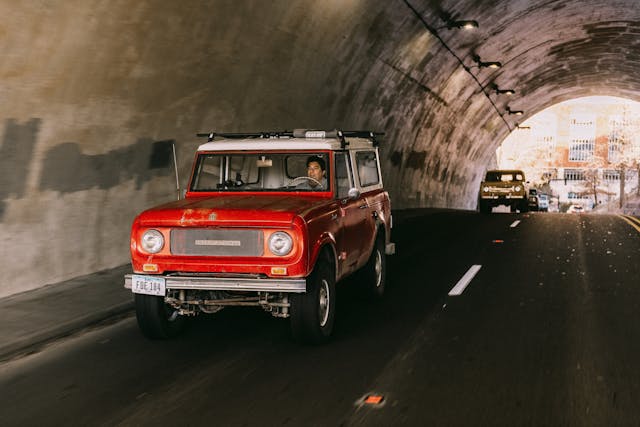
Turned out to be nothing. I had driven the Scout last and filled it at the gas station. What I didn’t realize was that the Scout had two gas tanks and two fillers, one on each side. I’d filled the tank on the driver’s side but not the one on the passenger side.
So, one of the other two journalists on the trip was driving along until the Scout ran out of gas. Barber flipped the switch to the other tank, which I’d never tapped into on account of not knowing it existed, and the red Scout was back in business. That was our final issue.
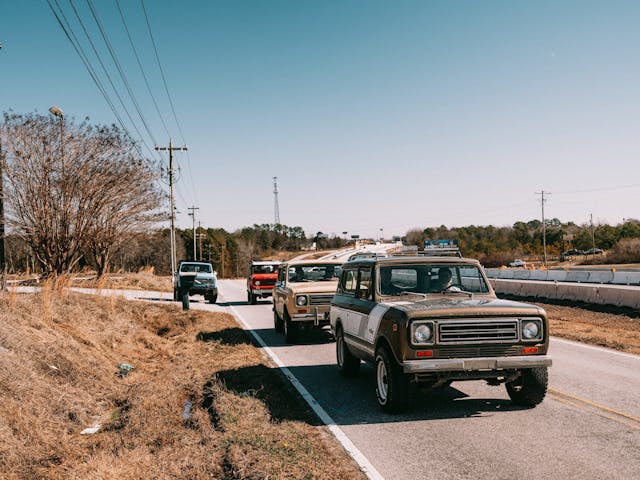
Aside from the ECU failure in the Chevrolet-powered white 1975 Scout II, the only real problem we’d encountered in more than 800 miles of driving was a dragging right rear brake on the bronze 1979 Scout II Rallye edition. That Scout II is owned by Navistar and had sat on display for years. “Almost all the springs in the brake were broken,” Barber said, after he pulled the wheel off. He fixed it, and the rig exhibited no more problems besides a slightly balky carburetor during our off-road adventuring.
On to Blythewood.
***
Three of the five vintage Scouts we drove from Fort Wayne, Indiana to the Scout Motors groundbreaking are owned by the aforementioned Sean Barber: The red 1967 Scout 800, the blue 1979 Scout II, and the yellow 1978 Scout II. He owns Anything Scout, which opened in 1993 in the San Francisco Bay Area. Barber and his wife, Heather, bought the company in 2003. In 2005, the company moved to Ames, Iowa.

He speaks fondly of all three Scouts, but it’s obvious he’s the most attached to that patina-laden 1967 Scout 800. “I’ve had it for about 25 years. I found it up in the mountains of Santa Cruz in the 1990s. I paid $500 for it, with the original paint, which it still has. It was not running at the time, so it’s been through several iterations of International engines. But now it’s back to its original configuration.”
That powertrain is a gutsy little 266-cubic-inch V-8, rated at 154 horsepower, mated to a four-speed manual with an unsynchronized first gear. It does not like to start off in second, so you’d best be up on your double-clutching. Otherwise, driving the old Scout was a breeze. The ride was firm but not punishing, and the steering was spot-on. The hood fluttered a bit on the highway; Barber had loaned the Scout to a friend, who had run it into a tree, denting the hood. That dent sort of complimented the gash on the driver’s side of the body, which was there when Barber bought the Scout.
While Anything Scout deals mostly in parts, Barber opened another company, New Legend 4×4, also in Ames, that does Scout restorations and powertrain conversions. There’s the Legend series, which takes “a respectfully restored original body on a modern chassis, integrates the latest technology in engine and drivetrain, provides all-new interior and upholstery, and curates luxury appointments with personality.” They start at $295,000. The Retro series “is built on the original frame and tastefully restored throughout.” They start at $205,000.
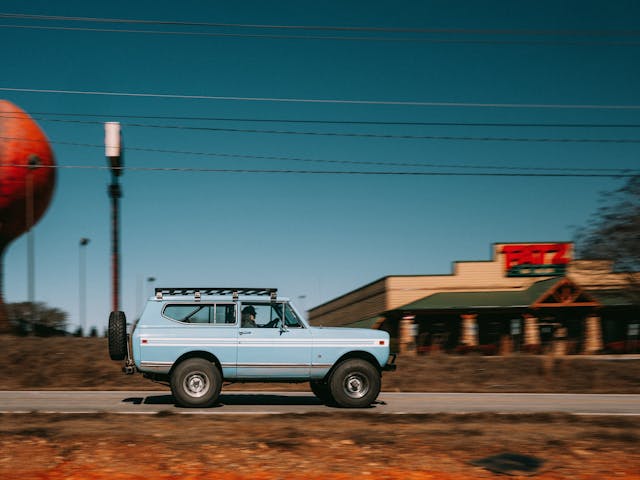
You may be wondering: Was Barber shocked that his three vintage Scouts made it all 800-plus miles with zero problems? “I’m happy they all made it,” he said, “but I’m not that surprised.”
Why Scout? “When I was about 24 years old, I’m 50 now, so it has been a while, I drove my first Scout. It was instant love at first drive. I was a muscle-car kid growing up. My wife, Heather, had just bought a brand-new 1993 Jeep Wrangler with the 4.0-liter fuel-injected six-cylinder. It was a great vehicle, but I just didn’t love it. It didn’t connect with me.
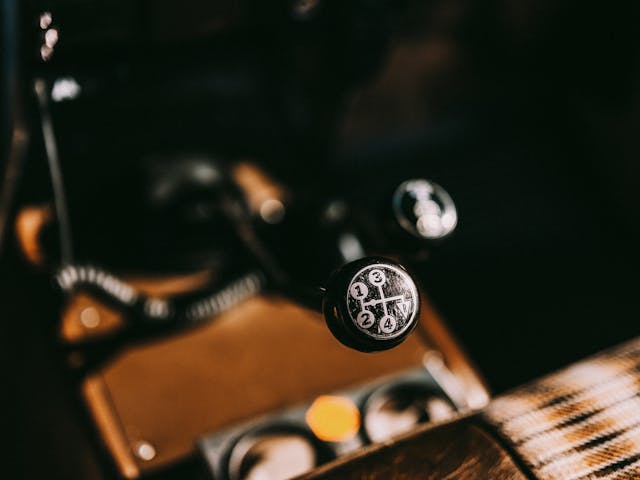
“But when I drove a Scout for the first time, a 1978 with a four-speed manual, it really spoke to me. In the next three years, I had four or five of them. Since then, my whole life has been dedicated to Scouts, and their preservation—introducing them to a new generation.”
So what in the Scout world has changed in the past 20 years? “I think the most exciting change is more young people discovering the brand. Young enthusiasts seem to value old things and a connection to the past, whether it’s the aesthetics or the mechanicals.
“With the rise in social media, there has been more connectivity between Scout owners, and I think that’s really good. Event attendance has been steadily growing, and with the introduction of the new Scout, I think more people will connect with the legacy models.”
***
It is no coincidence that the Scout Motors team is leaning into a connection with the past to help validate the new, all-electric Scout. At a media roundtable held on the new plant’s premises, Scott Keogh, president and CEO of Scout Motors, said that embracing the history of the Scout was critical to the new company’s marketing plan.

“You start at the highest level—what was the product, what did it do, what did it stand for? In my opinion, it basically invented the category that became the American market for an SUV. They built a vehicle that was highly capable,” Keogh said. “Honestly, they were ahead of their time.
“We love the very name. It’s a powerful thing. That name would mimic most every SUV. ‘Scout’ means to go first, and be followed by Explorer, and 4Runner, and Discovery, and Blazer, and Trailblazer, and on and on. So this is the godfather, the prototype, and a good place to start.”
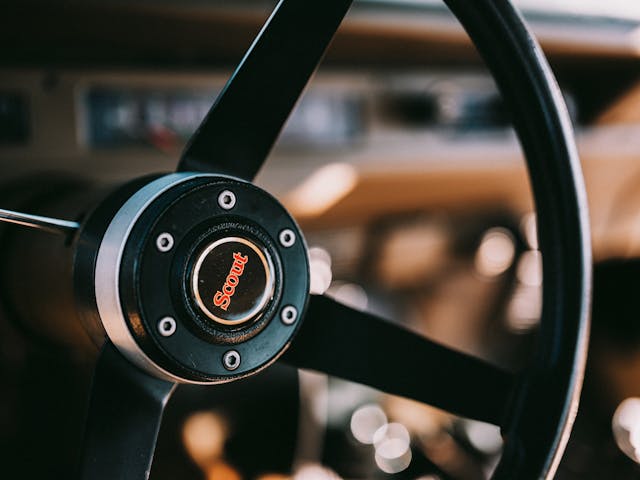
There are, Keogh said, hurdles to clear regarding the Scout’s integration into the SUV market. “Hurdle number one is if the Scout community doesn’t see us to be authentic and real, then you’re a poser. And if you’re a poser, it’s not going to work. The dream of any brand is that you start on day one with some momentum and love from the community.
“And once you get that, the next thing is to make sure we build something that is credible. If you have a mismatch between what the brand was anchored in and what you put on the market, that disconnect is going to be smelled out. I feel confident we have something that fits.
“But we also don’t want to be trapped in the ‘70s. It’s not as if we want to create Scout III. This will be the Scout VIII or IX, if you project it out. And why we did it is clear: It’s an American icon, and the time is right.”
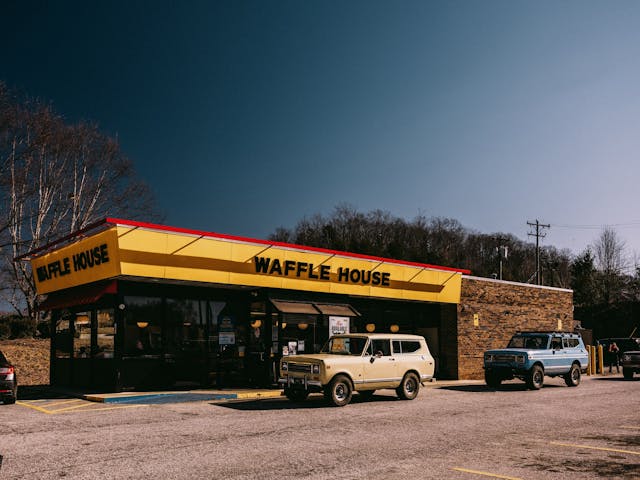
The new Scout SUV, and the pickup version which will follow soon after, will be body-on-frame, like a proper truck. “We want to build something that is highly robust, and highly capable,” Keogh said. “Scout came from that, and we want to keep that integrity.”
Of course, image is important: “I think of Scout a little bit like Levi’s. They can be worn in Malibu or a work site, and it’s a cool, iconic American brand,” Keogh said. “We’re not building something to navigate the strip malls of America, we’re building something that can navigate America.” The Scout will have “character and personality, that’s not an optimized jellybean.”
The electric Scout is expected to start around $50,000, before any government subsidies are applied. The plant, we were told, should be able to crank out 200,000 vehicles a year. Battery sourcing has not yet been determined.
The aftermarket possibilities should be huge, and Keogh said he and his staff are working on that. “The opportunities are massive. Some of the stuff we’re designing ourselves, some we’re finding good partners for, but I feel confident we’ll nail that.”
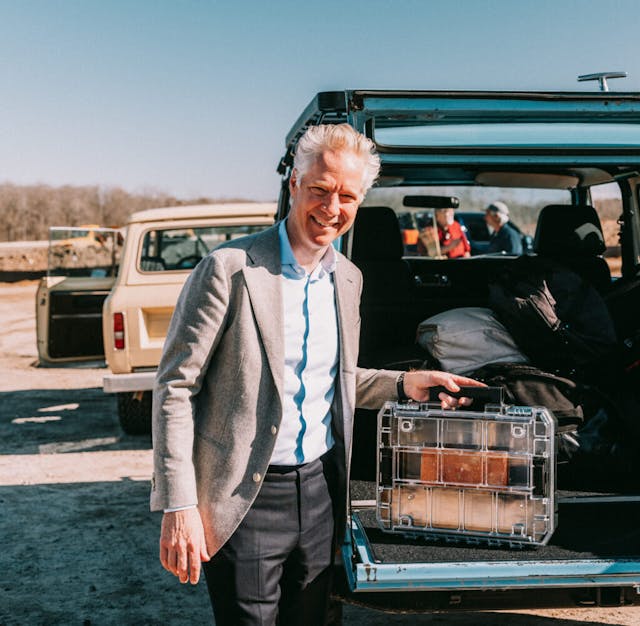
Yes, we were told, you can add lift kits if desired. Personalization, a massive source of income for the Jeep Wrangler and Ford Bronco, will be available at launch. So far, Scout has only released line drawings and a darkened profile shot of what the first production vehicle will look like. The company will unveil the Scout SUV this summer and the Scout pickup soon after. Production is expected to start by the end of 2026, with the Scout slated to go on sale in 2027.
Since Scout is owned by Volkswagen Group, the company faces no need to source financing for an electric start-up, as, say, Rivian and Lucid have had to do. That’s one reason there has been enormous interest in working there, as resumes (we are told) continue to pour in from engineers and designers. For the near term, Scout has sourced its top executives from VW: Keogh was, most recently, president and CEO of Volkswagen of America. Dr. Jan Spies is the head of production for Scout; previously he was head of planning and production technology for Volkswagen AG.
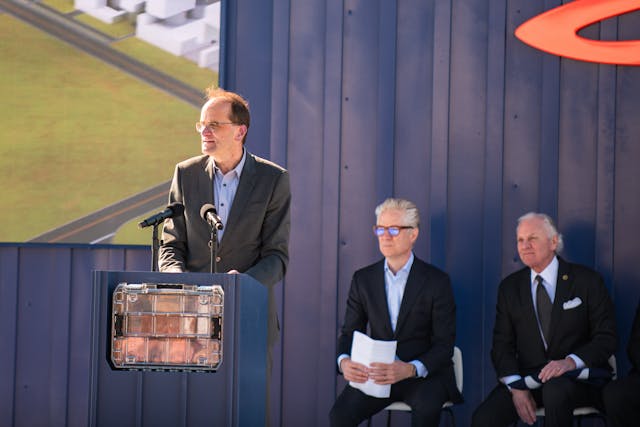
Right now, Scout Motors has 350 employees. At full production it is expected to have 4000. Getting the plant was a big win for the state of South Carolina: It is already a major auto production state, with the world’s largest BMW production facility located in Spartanburg, as well as Volvo and Mercedes-Benz assembly plants. Even before Scout, the automotive industry had an economic impact of $27 billion in the state, with $13.9 billion in capital investments from 2017 to 2023, according to the South Carolina Department of Commerce.
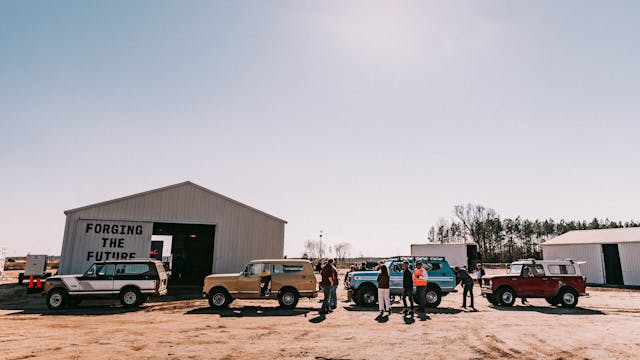
Scout considered 70 different sites for the plant before settling on this one: 1600 acres total, with the plant taking up 1100 acres. The land, just off Interstate 77, and 20 miles north of Columbia, was actually owned by Richland County. The county bought it from the owners, two farming families, and then began shopping it to various industries. South Carolina offered $1.3 billion in incentives to attract the Scout plant.
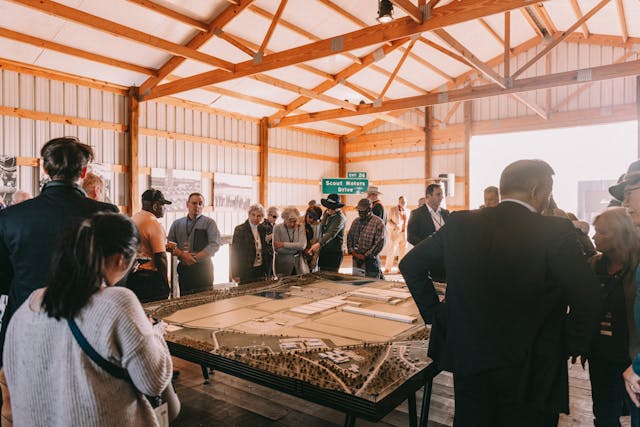
Finally, it’s no secret that the market for all-electric vehicles is sagging at the moment, and several manufacturers have dialed back their product planning. (Mercedes-Benz, for instance, recently scaled back plans for a global, fully electric lineup by 2030.) I asked Keogh if the company is considering a gasoline-powered version of the Scout, or at least a hybrid. “No,” he said. “We are a startup, which gives us the ability to pivot and move fast, which is a beautiful thing, right? We’re not married to legacy X or legacy Y. But as we look at the world, we think there is enough opportunity for a pure play, and that’s where we are right now.
“But look. We’re not naïve to the press headlines, we’re not naïve to the noise out there, and we’ll react accordingly,” Keogh said. “But I don’t think salvation comes from going back. I’m an optimist on technology, and an optimist on American technology.”
***
And finally, the groundbreaking. It was mostly ceremonial and obvious that the ground was actually broken on the site months ago. The earth had been cleared and leveled, and multiple pieces of construction equipment were working, beep-beeping in the distance as the speeches rolled on. There would be “no shiny shovels,” Keogh told the audience, no officials in suits and hardhats turning dirt.
A single red brick, part of the original International Harvester production facility—our classic Scout caravan brought it from Fort Wayne, Indiana, in a special clear-plastic carrying case—was front and center for the groundbreaking ceremony, inserted into the front of the lectern.
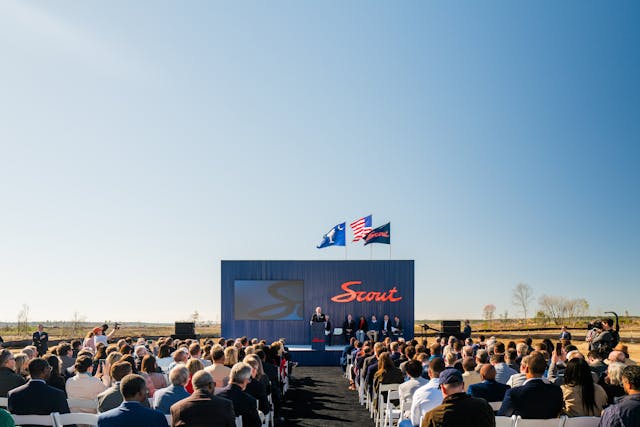
“What we’re doing here, “Keogh said, “is relaunching an American icon, and we’re doing it here in South Carolina. And frankly, we couldn’t be prouder to be doing it here in this beloved place.”
It all sounds good, but the product will ultimately need to do the talking. Scout loyalist Sean Barber hopes the new Scout is everything it’s promised to be. “It’s really cool that Scout Motors values the legacy. I feel like they are really honoring the heritage, honoring the past. They speak loudly to the community and the enthusiasts who have kept the brand alive for the past 40 years.”
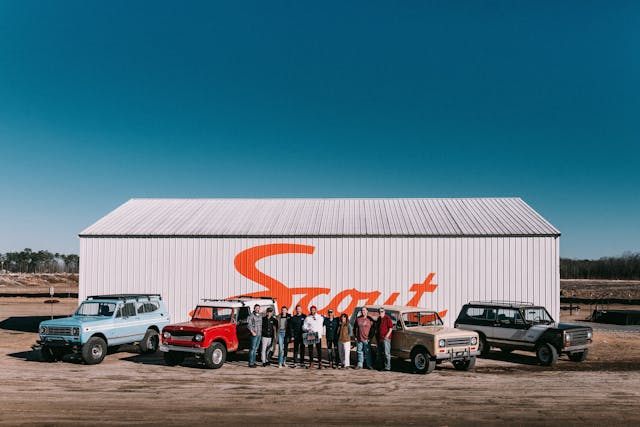

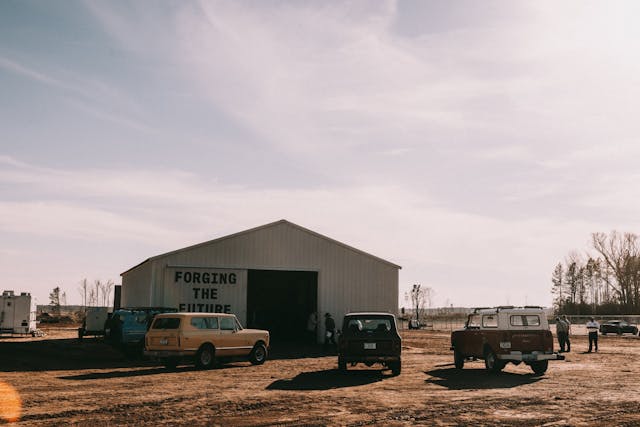
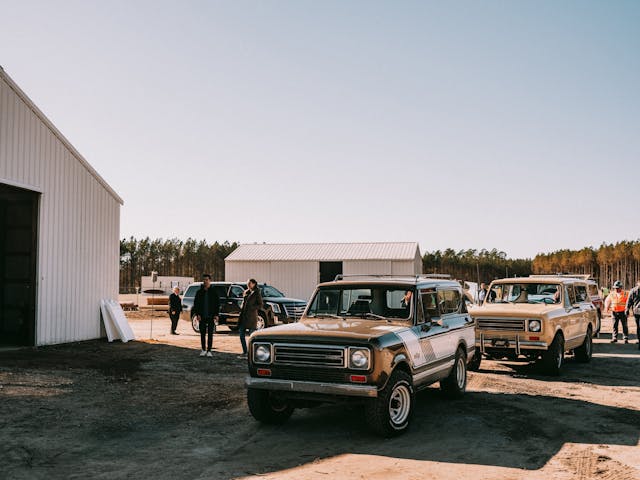
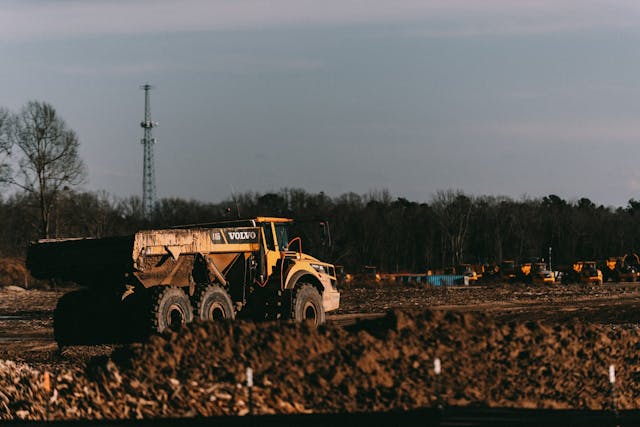
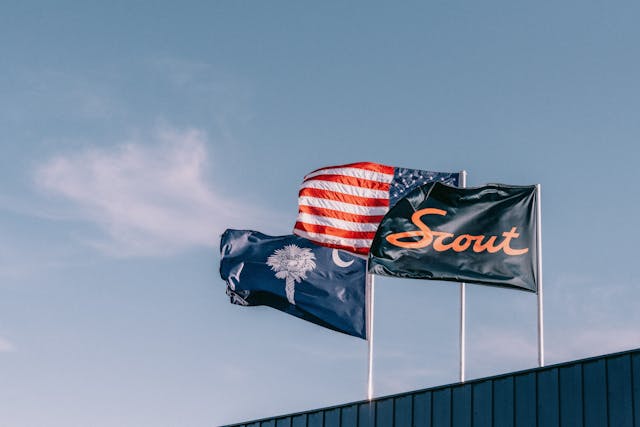
***
Check out the Hagerty Media homepage so you don’t miss a single story, or better yet, bookmark it. To get our best stories delivered right to your inbox, subscribe to our newsletters.



Dear Editor,
Please relay this message to VW if able: I will never purchase an electric vehicle. If their production includes, or switches to, internal combustion engines, I’ll drive down the road to SC and give them a deposit today. My grandfather owned a Scout in the ’70s but sold it before I was old enough to drive. It was the coolest vehicle ever, and, I still regret that it was not kept in the family. Thanks for the stories and long live the Scout.
P.S. – sure would like to have joined you on that journey from Ft. Wayne to Blythewood.
What is puzzling is the ICE driveline was the strength of the Scout. The problems were the bodies would rust and fall off.
A new body for the old chassis is what they need.
Precisely.
The real problem with an EV off road vehicle is the time it moves, not range. You can play in the rocks all day long and not go ten miles. If the new Scout won’t do that it needs to be a hybrid so you can get home or back to camp. My first 4×4 was a ’64 Scout and it taught me a lot of 4×4 basics. Like the importance of roll bars and seat belts. Lots of stories…
An EV scout is an immediate No to me. It’s just another EV VW to me. Now if they want to ditch the batteries and have a combustion motor as an electricity generator I might be interested. But batteries, forget it.
Loved seeing and reading your series.
The Scout came out when I was working on the family farm in Western Massachusetts. I believe the IH/Farmall dealer was close to closing just before Scout actually came out. There was, however, a IH truck dealership still doing business in the same city at that time and was able to supply the farmers with SOME tractor parts. It was at that truck dealer that I saw the new Scout and I thought it was the coolest vehicle ever.
As with other comments . . . I will not be driving a battery powered SUV. Give me a clean ICE, or at least a hybrid or I’ll be driving my current ICE SUV ‘til I’m dead (covered it with an 8/100,000 warranty) or the government pries it from my hands.
Narrow minded “car guys”. What do you suppose the previous “car guys” made their stand on? Tubeless tires? Automatic transmissions? Heck, some of them probably even made their stand on the internal combustion engine back around the turn of the twentieth century. Oh well, in the not too distant future the world will be moving on without you anyway. Then all the people driving electric cars will have to find something to make their stand on.